

Syntax: Verb Second
We know that Dutch is an SOV language because that is the order in the sub-clause. We also know that Dutch is a >verb second language. First let’s get convinced this is actually true. Is the verb in second position in Dutch?
| Ik | weet | het nog niet zeker. | - I’m not sure yet | |
| S | V | O |
|
|
| Jij | moet | het uitleggen. | - You have to explain | |
| S | V | O |
|
|
| Wanneer | overtuig | je | me? | - When will you convince me? |
| V | S | O |
|
|
| Ik | denk | zometeen. | - I think in a moment. |
|
| S | V |
|
||
| Zometeen | denk | ik. | - In a moment I think. | |
| V | S |
|
||
| Dat | denk | ik | ook. | - ‘That think I too’ (I agree). |
| O | V | S |
|
|
| Ik | denk | dat | ook. | - I think that too (I agree). |
| S | V | O |
|
|
| Geloof | je | me | nu? | - Do you believe me now? |
| V | S | O | ||
The last sentence is a >yes/no question (it can be answered by yes or no) and it seems to be the only exception to the >V2 rule. All the other sentences have the verb in second place. Even when you have two sentences with the same words that mean the same (‘I agree’), you can change the order of all the words but the verb stays in second position. Apparently word order in Dutch is pretty free, but the V2 rule is very strict. This becomes clear when we revisit a sentence used earlier:
| Klazina | vindt | Guus | leuk. |
| S | V | O | |
| Klazina | finds | Guus | nice. |
| (Klazina likes Guus) | |||
With the right stress on the first word, this sentence can also mean:
| Klazina | vindt | Guus | leuk. |
| O | V | S | |
| Klazina | finds | Guus | nice. |
| (Klazina Guus likes |
|||
This might be a bit difficult to understand if you’ve just started learning Dutch, so don’t worry about it too much. The important thing is that you know that the Dutch >verb second rule is very strong. We hope you realise that this is not just some theoretical fact. You can use this knowledge to improve your Dutch: remember that in main clauses the verb comes in second place and in sub-clauses it comes in final place.
| Jij | weet | nu | dat | je | je Nederlands | verbeteren kan. |
| S | V | C | S | O | V | |
| You | know | now | that | you | your Dutch | improve can. |
| ‘You know now that you can improve your Dutch’ | ||||||
In English it is possible to have two elements before the finite verb:
Tomorrow John arrives.
This is not possible in Dutch!
* Morgen Jan komt.
OK Morgen komt Jan.
OK Jan komt morgen.
V2 in more detail
You might realise now that once you start analysing language it’s hard to stop. You may have noted that in the last example we called ‘verbeteren kan’ a verb. Quite obviously it’s actually two verbs. A lot of sentences have more than one verb, so how do you know which one goes where? Perhaps it helps to look at the following main clauses (V2!):
| Ik | ga | op | vakantie | I go on vacation. | |
| S | V | ||||
| Hij | gaat | jou | helpen | He goes you help |
|
| S | V | O | V | ||
| Wij | gaan | de | zin | analyseren | We go the sentence analyse We will analyse the sentence |
| S | V | O | V |
The last two sentences have two verbs. The verbs are not completely equal. One is related to the verb more closely than the other:
werkwoord: gaan
| ik | ga | 1st person, singular |
| jij | gaat | 2nd person, singular |
| hij/zij | gaat | 3rd person, singular |
| wij | gaan | 1st person, plural |
| jullie | gaan | 2nd person, plural |
| zij | gaan | 3rd person, plural |
You can see the verb ending changes depending on the subject. This is called >inflection. In this case the verb is >inflected for >person and number (x th person, singular or plural). A verb can also be inflected for >tense. For example, a verb can be in the >present tense, or in the >past tense. The list above is *present tense, the list below *past tense. You can see that the verb can be inflected for both person/number and tense:
werkwoord: gaan (verleden tijd (past tense): gingen)
| ik | ging | 1st person, singular, past tense |
| jij | ging | 2nd person, singular, past tense |
| hij/zij | ging | 3rd person, singular, past tense |
| wij | gingen | 1st person, plural, past tense |
| jullie | gingen | 2nd person, plural, past tense |
| zij | gingen | 3rd person, plural, past tense |
An inflected verb is called a >finite verb. A verb with no inflection is called the >infinitive. In English this is often the form with ‘to’ in front of it: ‘to go’, ‘to analyse’, ‘to be’ etcetera. In Dutch the *infinitive often ends with –en or –n:
worden
analyseren
hebben
gaan
For Dutch, in >regular verbs the >stem of the verb is the infinitive minus –en. The stem is often the form of the 1 st person singular. 2nd and 3rd person are then ‘stem + t’. You may remember this from Dutch classes or textbooks.
It is the finite verb that goes in second place in main clauses and the infinitive(s) are in the final position. In sub-clauses the finite verb is in the final position. Recall that the final place of the verb in sub-clauses can be explained by the fact that the Dutch predicate is head-final. We now have to find an explanation for the fact that the finite verb comes in second place in main clauses.
Name the inflection of the following verbs. Past or perfect, 1st or 2nd person?
Word order derived from SOV order - advanced
We have yet to explain how the fact that Dutch is both >V2 and >SOV can be explained. Recall how in English questions starting with a >wh-word the s>urface structure (the one that you hear) is different from the >underlying structure:
* You have seen what? - underlying
What have you seen? - surface
We said that ‘what’ moved to the initial position. A similar sort of movement is assumed to explain Dutch word order. In these sentences it is the verb that moves. The idea is that in the underlying structure word order is always SOV, but in some cases the verb moves up to the V2 position.
In order to understand this we have to look at a constituent smaller than a clause, called a >phrase. A phrase is built around one important word which is a member of one of the major word classes (Noun, Verb, Adjective, Determiner, Preposition). This important word is called the >head of the phrase. If the head is a verb, the phrase is called a >verb phrase (VP). The verb phrase consists of the verb and an optional object (depending on whether the verb is transitive). In a tree structure it looks like this (Diagram 1):
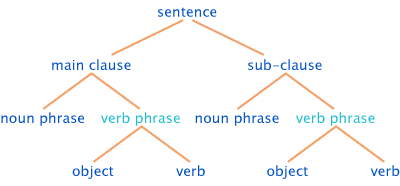
Note that the VP takes the position of the predicate in the earlier tree. In many languages the predicate is a VP.
In the Dutch main clause the verb has to move to account for the word order, which is not SOV. It is the finite verb that moves. Linguists think that a verb moves to get inflected for number/person and tense. Just like the verb is the head of a verb phrase, they think that inflection is the head of an inflection phrase (IP). One example of Dutch inflection is the 3rd person singular ‘t’ in ‘hij werk t’. This is how that could work (Diagram 2):
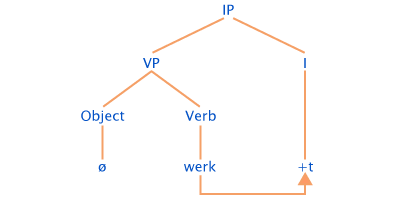
Of course this still does not explain the word order of the Dutch main clause. That explanation involves more structure and more phrases. We distinguish between >categorical phrases such as noun phrase and verb phrase, and >functional phrases such as the inflection phrase. Functional phrases are assumed to explain grammatical features such as inflection and the initial position of a wh-word. Another phrase that is assumed for grammatical reasons is the >complementizer phrase (CP). This word should sound familiar; sub-clauses often start with a complementizer.
We will not discuss these phrases in any detail. Instead we want to show you a complex tree with a number of phrases. With the knowledge we have gained in this chapter it is not very hard to get from the simple tree you saw before to the more complex tree. We will do it in 4 steps.
We are going to build a main clause from the following three elements:
| subject: | hij | he |
| object: | een koekje | a cookie |
| verb(s): | eten, gaan | to eat, to go |
We know the underlying order of every Dutch sentence, so we can just insert these elements (Diagram 3):
Step 1:
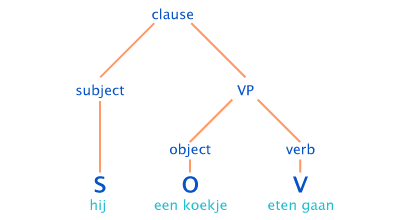
We also know that the finite verb needs inflection which it can get in a functional phrase called an inflection phrase (IP). In Dutch the IP is assumed to be head-final, just like the VP (Diagram 4):
Step 2:
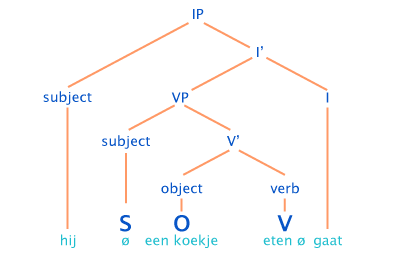
:: click here to see heads of the tree ::
Some linguists say that the subject also belongs in IP, so that’s why we have moved the subject. The Ø means that something moved from that position, leaving a gap. This also happened with ‘gaan’ which moved to I to get inflected. The structure above is almost the structure of the Dutch sub-clause, the word order is correct for a sub-clause. Of course, the word order of the Dutch main clause is different. The verb needs to be in second position. We can explain this if we assume another functional projection (CP). All clauses have a CP, an IP and a VP. The verb can now move to C (Diagram 4).
Step 3:

This is still not the exact word order. The subject needs to precede the verb. The following tree shows the complete structure of a Dutch main clause, where the verb has moved to C and the subject has moved to the position before that, called SpecCP (Diagram 5):
Step 4:
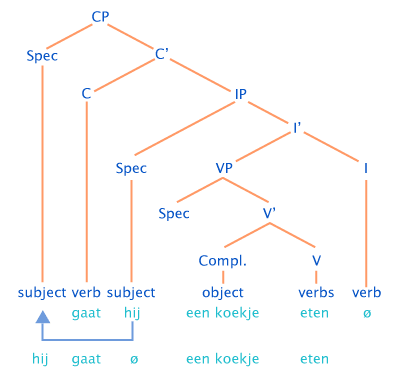
Ignoring the difficult structure of the tree, we can see that the underlying (step 1) word order is SOV – ‘hij een koekje eten gaan’. The finite verb moves to I to get inflected, this is the orange arrow in step 3. The sentence is now: ‘hij een koekje eten gaat’. (Remember: the Ø means ‘nothing’ and it represents that something was there but has now moved, leaving a gap.) Now the finite verb moves to C, because that is the second position in the sentence and that is where the Dutch finite verb wants to be. This is the blue arrow in step 3. The sentence is now: ‘gaat hij een koekje eten’. This is not the right word order, so the subject has to move to get the final and correct ‘Hij gaat een koekje eten’ (step 4).
:: click here to see how an English main clause is built! ::
The tree above is how it works for a Dutch main clause. The CP is called a complementizer phrase, as we have seen. Its head is often a complementizer, and as we have seen sub-clauses often start with complementizers (‘that’, for example). We can now explain why in sub-clauses the verb cannot move to the second position: this position is already taken by the complementizer (Diagram 6)!!
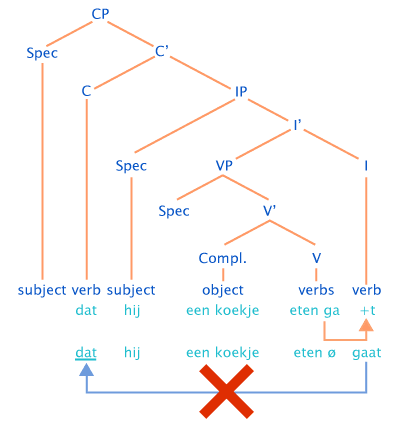
This means that ‘gaat’ cannot move to the second position, so the only possible word order for the sub-clause is: ‘dat hij een koekje eten gaat’. This is indeed correct.
Build a main clause yourself from the following elements:
- subject: Els
- object: een kast
- verb: maken
Conclusion
You can be very proud of yourself. We covered the basics of syntax in a very short time. Perhaps it is a good idea to give it some time to settle and perhaps read things you found difficult again later. Don’t be spooked if you didn’t get it all in one go, this is a difficult topic. Now that you’re familiar with a different way of looking at language and you’ve learned some of the basic terminology the other chapters should be an easier read!
We will conclude the syntax part of this course by applying the things we have learned so far to a feature of Dutch that many people learning Dutch find very difficult: the use of ‘er’ (there). You’ll find that a structural study of the usage of ‘er’ will help you to use it correctly yourself.
next![]()
(ER)
